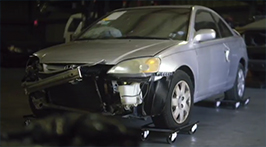In the U.S., an estimated 7.4 million swimming pools are in public or residential use, with swimming rated as the third most popular recreational activity in the country and the most popular activity for children. Out of the millions of pool users, the U.S. Consumer Product Safety Commission (CPSC) estimates that at least 50,000 people will require emergency medical treatment for swimming pool accidents each year, with nearly 300 children under the age of 5 dying from pool-related injuries.
Drowning Dangers
While swimming pools and spas may be popular for recreation, drowning and near-drowning incidents are a real danger for pool users, especially young children with access to a residential pool. A young child may drown in as little as one inch of water, with a loss of consciousness occurring within two minutes of submersion and irreversible brain damage occurring within four to six minutes.
Drowning is the leading cause of death for children under the age of 5 in Florida, Arizona, and California, and is the second-leading cause of unintentional death among all children ages 1 to 4 years and 10 to 14 years. Child supervision does not always guarantee pool safety, as 88 percent of children who drowned were reported to be under some form of supervision by a parent, family member, babysitter, or neighbor.
Entrapment Dangers
Aside from pool drowning incidents, pool drain entrapments are one of the most commonly reported swimming pool or spa related causes of injury or death. Drain entrapment occurs when the strong suction on pool, spa, or whirlpool drains causes a swimmer’s body, hair, bathing suit, or jewelry to become sucked into the drain, trapping the swimmer at the bottom of the pool.
The CPSC ranks pool and spa drains as one of the top five most dangerous hidden home hazards, citing that pool drain suction is often so powerful that it can hold an adult under water. Pools with broken or missing drain covers pose the highest risk of strong suction.
From 1999 to 2008, the CPSC received 83 reports of entrapments on pool, spa, or whirlpool tub drains, including 11 fatalities. Most incidents occurred in children ages 5 to 9.
Pool Equipment Recalls
Safety recalls affecting pool and spa equipment include:
Pool Safety Tips
With the proper pool safety measures, all drowning, near-drowning, and entrapment incidents are preventable.
- Always supervise children in and around the water
- Use non-slip materials on pool decks, diving boards, and ladders
- Learn to swim and teach children to swim as soon as possible
- Do not leave toys in pool areas when the pool is not in use
- Have rescue equipment and a phone near the pool in case of emergency
- Check that drain covers are not missing or broken
- Place a safety float line where the pool bottom begins to slope downward into deeper water
- Fence in pool areas with self-closing or self-latching gates and four-sided isolation fencing that stands at least 4 feet high
- Consider installing in-water pool alarms or safety covers for pools when they are not in use
Pool Accidents
The most commonly reported causes of pool- and spa-related injuries include:
- Drain entrapment
- Falling on slippery walkways, decks, diving boards, or ladders
- Striking the bottom or sides of a pool in shallow water
- Drowning
- Injuries from diving boards or pool slides
Pool Safety Acts and Regulations
Congress passed the Virginia Graeme Baker Pool and Spa Safety Act on December 19, 2007, which addresses the safety of swimming pools and spas by requiring anti-entrapment drain covers on all public pools and spas, establishing a federal swimming pool and spa drain cover standard, and requiring fencing around all outdoor residential pools and spas to prevent accidental drowning.
The Act was pushed through Congress after 7-year-old Virginia Graeme Baker, the daughter of James Baker IV, son of former Secretary of State James Baker III, was trapped at the bottom of a hot tub by the powerful suction of a spa drain. The drain had to be broken in order to release Graeme’s body from the suction, but it was too late and the girl died.
Sources:
- http://www.poolsafety.gov/
- http://www.cpsc.gov/CPSCPUB/PREREL/prhtml76/76029.html
- http://www.safekids.org/our-work/research/fact-sheets/drowning-prevention-fact-sheet.html
- http://www.safekids.org/safety-basics/safety-resources-by-risk-area/drowning/
- http://www.cdc.gov/healthywater/swimming/pools.html
- http://www.cpsc.gov/cpscpub/prerel/prhtml05/05178.html
